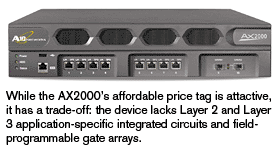Review: Keeping The Balance

The AX Series 2000 appliance is a 2U box with 2 Gbytes of memory and 8-Gigabit Ethernet ports. Inside, the device has two processors, 2-Gigabit Ethernet SPF fiber ports and an 80-Gbyte hard drive.
The unit's graphical user interface is intuitive, and the command-line interface is also easy to use. Customers or solution providers managing the appliance can choose which management method is preferable.

The controller accelerates and optimizes all applications across all servers under both normal and peak usage conditions. Sitting between the data center and the rest of the corporate network, the AX Series device also terminates SSL sessions with the machines trying to access the servers in the data center. This frees up the servers from tying up CPU cycles to deal with SSL sessions. AX2000 performs Layer 4 and Layer 7 acceleration and supports IPv4 and IPv6.
While some customers will be attracted by the affordable price tag, it has a trade-off: The device lacks Layer 2 and Layer 3 application-specific integrated circuits, and field-programmable gate arrays for traffic allocation. Because the switch is running a program off the CPU instead of a dedicated microchip to route network packets, it's slower than high-end enterprise-level models. The difference is noticeable in high-end, high-traffic situations, which is why the AX2000 is not targeted at those environments.

Careful planning makes deployment both fast and smooth. Solution providers can pre-configure the AX2000 with the customer's network configuration settings before installing the unit. Solution providers can also be accompanied by A10 technicians for additional support during deployment.
A10 included its proprietary Application Specific Integrated Circuit technology for SSL acceleration, high-performance switching and routing. The AX Series appliance features multicore CPUs running the company's Advanced Core Operating System (ACOS). Designed for performance, scalability and reliability, the OS is tuned specifically for multiple processors with multiple cores. With native multisystems support, ACOS scales performance across multiple decoupled CPUs to ensure maximum scalable performance.
Changing hardware is not the only challenge customers face about future scalability. New applications are also a factor. The controller includes a policy editor that uses its aRule scripting language to design and create application policies. Doing so allows customers to create traffic inspection, application redirection and switching policies. As additional applications are deployed on the network, customers can create new policies for load balancing.
A10 touts the AX2000 controller for delivering higher performance at a lower price point than its competitors, which is good news for solution providers looking at margins. The company says solution providers can expect anywhere from 20 percent to 40 percent margins for deals that have been registered.